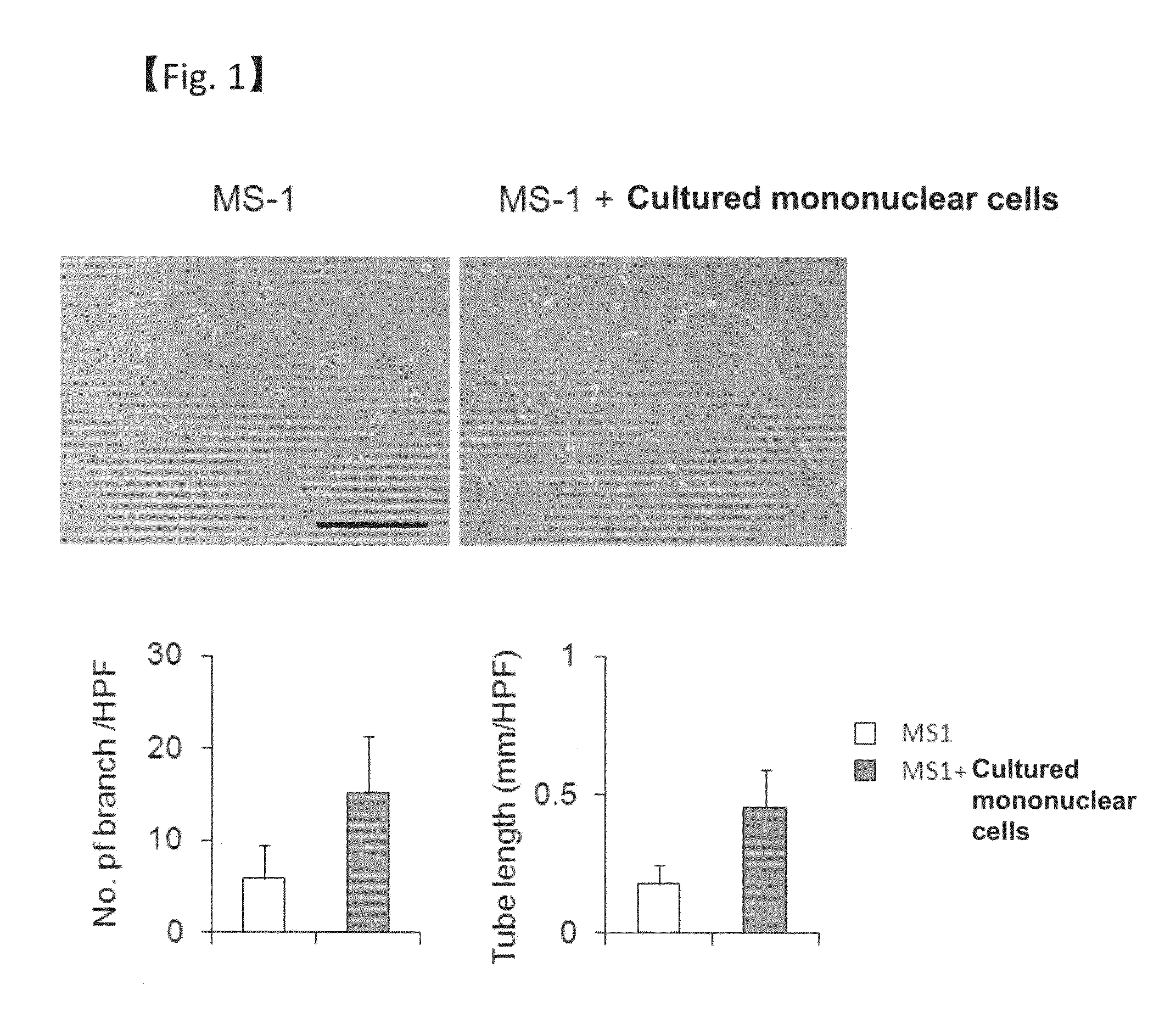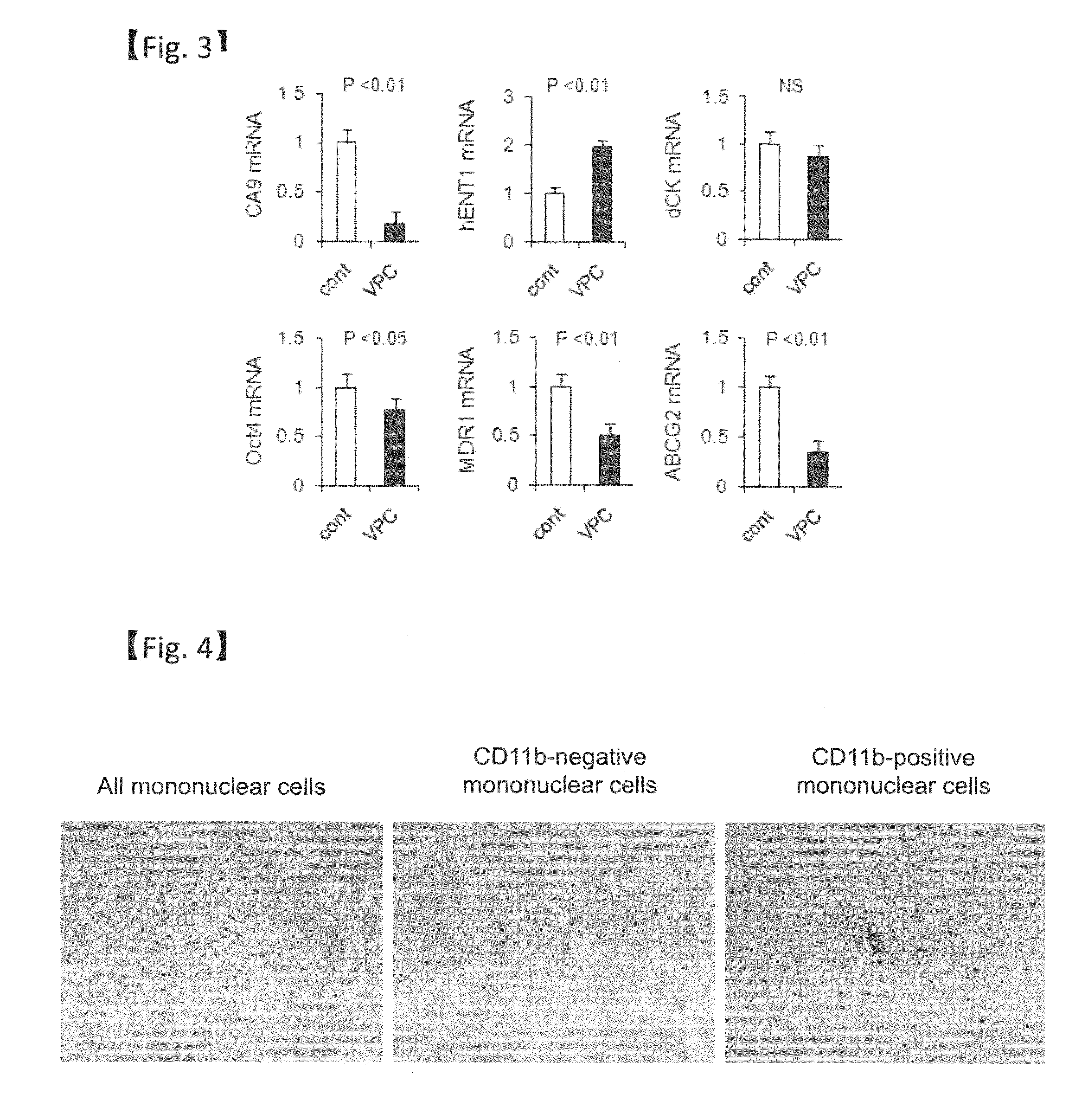Revascularization cells derived from mononuclear cells, and method of inducing differentiation thereof
a revascularization cell and mononuclear cell technology, applied in the field of new revascularization cell population derived from mononuclear cell population and the method of inducing differentiation thereof, can solve the problems of difficult collection of enough cells needed for a certain therapeutic effect, a long way to be realized, and a very low occurrence of subculturable cells from pavement-shaped colonization, etc., to achieve no risk of infection, promote lumen formation, and collect peripheral blood relatively
- Summary
- Abstract
- Description
- Claims
- Application Information
AI Technical Summary
Benefits of technology
Problems solved by technology
Method used
Image
Examples
example 1
Induction of Differentiation of Mouse Mononuclear Cells in EGM2-MV Medium
[0133]From mouse bone marrow, the mononuclear cells were prepared as follows. Mouse thighbone etc. were crushed by using a mortar and DPBSE (PBS containing EDTA at the concentration of 5 mM), and bone marrow fluid was collected. The collected bone marrow fluid was filtrated using a membrane filter of 70 μm diameter to collect bone marrow cell suspension. The cells were suspended in 10 ml of DPBSE. This suspension was gently overlayed on 4 ml of Histopaque 1083 (Sigma) in a 15 ml centrifugal tube. After separating this mixture by density gradient centrifugation (400 g at room temperature for 20 minutes), cells layered in the middle were collected with pipette to isolate bone marrow mononuclear cells (BM-MNC).
[0134]The obtained mouse bone marrow mononuclear cells were cultured with inducing differentiation for one week in EGM2-MV medium supplemented with 10% FBS in a temperature sensitive culture dish treated wit...
example 2
Induction of Differentiation of CD11b Positive-Fraction of Mouse Mononuclear Cells
[0145]Mononuclear cells were prepared from mouse bone marrow similar to Example 1. Next, a CD11b-positive fraction is prepared from the obtained mouse bone marrow mononuclear cells using immunomagnetic beads (Miltenyi Biotec.) on which a CD11b antibody is immobilized.
(1)
[0146]Among cells in the CD11b-positive fraction, adherent cells in spindle shape similar to all mononuclear cells were observed. On the other hand, cells in similar shape were scarce when the CD11b-negative fraction was used (FIG. 4). From this, cells in spindle shape seen in the early stage of culturing are considered to be of monocyte origin.
(2)
[0147]When cells in the CD11b-positive fraction were cultured for three weeks in EGM2-MV medium supplemented with 10% FBS in a culture dish treated with rat vitronectin, the expansion and enlargement of cells were seen, but the cells showed no tendency of proliferation. Thus, CD11b-positive ce...
example 3
Induction of Differentiation of Human Mononuclear Cells Under Various Conditions
[0150]20 mL of DPBSE was added to 30 mL of peripheral blood obtained from a healthy volunteer. Baffy court was collected by spinning it at 400×g, 20° C., for 35 minutes. It was resuspended into 20 mL of DPBSE, then separated by density gradient centrifugation (400 g at room temperature for 20 minutes) using Histopaque 1077 (Sigma). Mononuclear cells were isolated by collecting cells layered in the middle with pipette, and cultured in EBM-2 supplemented with EGM2-MV medium kit for microvascular endothelial cell medium (Lonza) on a plate coated with human fibronectin for 4-0.7 days to obtain adherent cells.
(1)
[0151]Human peripheral blood mononuclear cells were cultured with inducing differentiation in EGM2-MV medium supplemented with 10% FBS in culture dish treated with human fibronectin. It was confirmed that cells keep round-to-spindle shape well for about one week of culture period, when cultured for ab...
PUM
 Login to View More
Login to View More Abstract
Description
Claims
Application Information
 Login to View More
Login to View More - R&D
- Intellectual Property
- Life Sciences
- Materials
- Tech Scout
- Unparalleled Data Quality
- Higher Quality Content
- 60% Fewer Hallucinations
Browse by: Latest US Patents, China's latest patents, Technical Efficacy Thesaurus, Application Domain, Technology Topic, Popular Technical Reports.
© 2025 PatSnap. All rights reserved.Legal|Privacy policy|Modern Slavery Act Transparency Statement|Sitemap|About US| Contact US: help@patsnap.com



